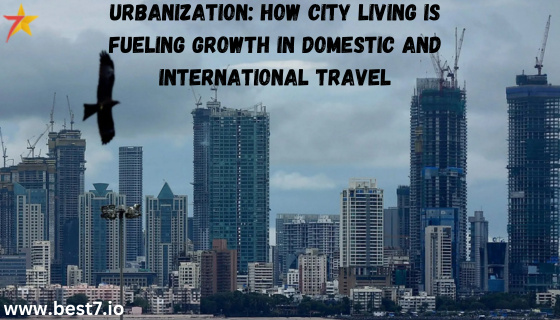
Urbanization is one of the most influential processes that continue to shape the modern world, and its impact extends to the travel industry. With the rapid expansion of the urban environment and the increasing concentration of people in cities, both domestic and international travel demand and its growth are dramatically boosted.
As cities continue to grow and their share of the global population increases, there is a greater number of travelers looking for urban experiences. Therefore, as more and more people choose to live in cities, they also start to perceive cities as a desirable destination for both leisure and business travel.
By examining the relationship between urbanization and travel, it is possible to understand how urbanization has impacted the growth of tourism and influenced travel trends across the world. By examining cases from the past and looking at future trends, the paper will explore the impact of urbanization on trends in travel in the city.
The Rise of Urban Tourism and Associated Travel Trends
With the growth of the urban environment associated with the process of urbanization, new trends in travel emerged while also influencing the global tourism market. As cities become the centers of culture, business, and social life, a new type of traveler emerges, with more tourists drawn to vibrant urban environments.
In fact, cities often represent some of the most traveled destinations globally, and the trends associated with city tourism influence the development of tourism to such a degree. A case study from 2018 focusing on the growth of tourism in New York City explores the role of urbanization in the expansion of the role of cities as destinations for visitors.
That year, New York welcomed more than 65 million tourists, a 5% increase from the previous year, with a significant share being international travelers. The increase in city tourism was primarily explained through urbanization, which drew people to urban environments to experience New York’s cultural life, a variety of landmarks, and restaurants.
In addition, the case of New York shows that domestic tourism was also a significant factor, as more Americans preferred cities and urban areas to rural locations.
Future Trends in Urban Tourism
Urban tourism is expected to remain a prominent feature in the future of the travel industry. Recent reports forecast that by 2030, it will make up 60% of all global tourism, with top urban hot spots such as Paris, Tokyo, and Dubai taking the lead.
As global urbanization transforms our travel landscape, city-minded travelers will continue to seek out authentic experiences that reflect the fast-paced, culturally rich lives they have away from home. Given the increasing urbanization of the global population, by 2040, 70% of the world’s population is expected to reside in urban areas.
As such, domestic travel will undergo a substantial change, with travel demand increasing by 40% over the course of the next two decades. Domestic and international travel trends will be heavily influenced by these urban travel dynamics, as intercity cities will have an increased connection.
Additionally, urban dwellers will transition between local and international travel as they continue to habitat various urban areas. As such, this post will estimate seven ways through which urbanization has affected domestic travel.
Domestic Travel Trends Influenced by Urbanization
Urbanization has heavily impacted domestic travel, as more and more people residing in cities opt to visit other urban locations in their home nations. However, these domestic travel trends are not stand-alone; rather, they are closely associated with the dynamics of urban living. Currently, seven means through which urbanization influences domestic travel could be noted and used in evaluating travel forecasts.
- Weekend Travel: Weekend overtime, the lives of city residents have become increasingly fast-paced. Every city resident wouldn’t mind a short weekend getaway to the nearest city that serves humanity! Civilization! Hope! Dreams! In 2025, the overall weekend domestic travel numbers should increase by 25%, with short-term tourism predictions for Los Angeles increasing by 35% and for London, the growth will be 40%.
- Festivals and Random City Events: Every city cherishes an array of cultural or non-cultural events that attract domestic tourists. By 2030, the events in the city will lead to a 15% increase in domestic luxury travel and accommodation.
- Business Travel: With the growth of business districts in various cities, business travel is expected to increase. Domestic business trips will increase by 30%, to a peak in 2028.
Cultural and Transport Factors Driving Travel Growth
Below are some of the factors and reasons that have driven the growth of domestic tourism and which have a direct relation to urbanization.
- Cultural Tourism: Urban travelers have developed an appetite for the cultural offerings of other cities, with museums, art galleries, and other cultural places being among the highly visited ones. By 2035, the drive for city tourism is expected to grow by 20%, especially for cities such as Rome, Berlin, and Kyoto, which have renowned cultural establishments.
- Improved Domestic Means of Transport: Urbanization has led to the spread and growth of transport systems within the cities, which has made it relatively easier for people to travel across the cities. By 2030, we expect the number of city travelers to grow by 35%, driven mainly by the inner city rail systems and budget air travel.
- Staycations: The desire of city travelers to travel within cities has given rise to “staycations,” where urban travelers opt to take hours away from work and home to visit different areas of the city. A Morgan Bank Stanley Research report projects that by 2025, staycations will account for 10% of the total domestic travel.
- Urban Adventure Tourism: Urban cities are also growing in their appetite for new and collective experiences away from what the normal offers. The new urban tourism, which includes new ways of exploring and is likely to take up around 15% of city tourism, includes urban hiking, biking, and rooftop looking, among others.
There is a major correlation between urbanization and city tourism, as shown above, where the form is playing a major role in driving domestic travel.
The Direct Role of Urbanization in Driving International Tourism
Urbanization has also played a major role in driving international tourism. As cities become more diversified centers of life—business, industrial, commerce, arts, culture, and innovation—they draw interest from other people, both internally and internationally.
International tourism is rising, mostly because of the vastness and allure of the diversity of the urban attractions that include both natural and manmade. Most of the new urban visitors are keen on creating a new and diverse urban experience.
The relation between urbanization and international tourism is quite obvious: the former process contributes to the growth of the traveling needs of the population. Both domestic and international tourism is driven by the growth of urbanization rates in numerous countries throughout the world.
The connection could be illustrated with the examples of the existing international urban tours that offer unique experiences for travelers and exploit the growing interest in urban exploration.
The impact of urbanization on tourism can be explored with data provided in a 2020 case study: “International urban tourism has increased by more than 20% in cosmopolitan cities—such as Barcelona, Amsterdam, and Prague—over the past five years.”.
Tourist Preferences Shifting Towards Urban Destinations
While the growth may seem sudden, the relationship between the two processes might explain the observed increase. International tourists are looking for more cosmopolitan cities that offer the benefits of a modern metropolis, world-class museums, attractive historical and cultural sites, and fine dining.
It was also mentioned in the study that urban destinations were 20–30% more popular among tourists than their rural or coastal alternatives. The findings could also be applied to future projections about the growth of urbanization.
According to a forecast by 2035, international tourism will have grown by 50%, where the majority of the growth will be generated by urban destinations. This process is logical due to the increasing mobility of the international population, looking to experience the rich culture, history, and opportunities that cities offer today.
At the same time, the growth of globalization will increase the number of cities located in emerging markets (Asia and Africa) that will be able to increase their international attraction. For a vivid example, the report mentions that Macau, Taipei, Kunming, and Chongqing will also be international tourism hubs, while, today, Nairobi, Mumbai, and Jakarta are gradually on track to become global cities as well.












